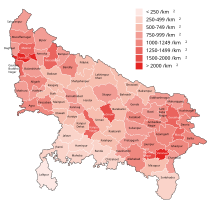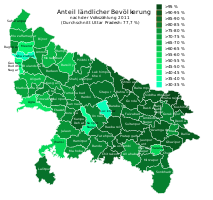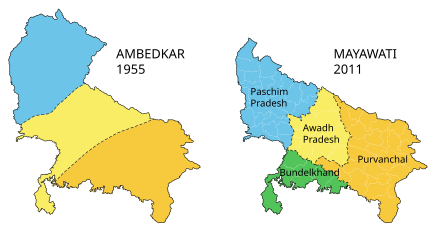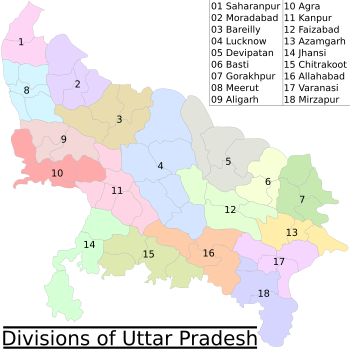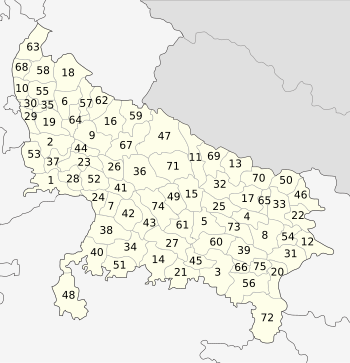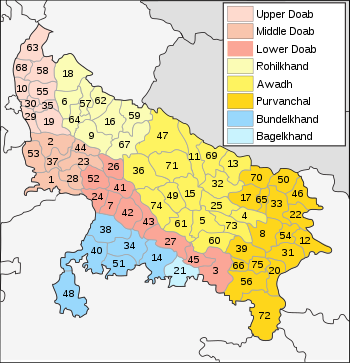Uttar Pradesh
| status | State |
| Capital | Lucknow |
| surface | 240,928 km² |
| Residents | 199,812,341 (2011) |
| Population density | 829 inhabitants per km² |
| languages | Hindi , Urdu |
| governor | Pineapple Patel ( BJP ) |
| Chief Minister | Yogi Adityanath ( BJP ) |
| Website | up.gov.in |
| ISO code | IN-UP |
Uttar Pradesh ( Hindi उत्तर प्रदेश IAST Uttar Pradeś [ ˈʊttʌr prʌˈdeːʃ ]; Urdu اتر پردیش; literally: "northern federal state", UP for short ) is an Indian state with an area of 240,928 square kilometers. With almost 200 million inhabitants (2011 census), Uttar Pradesh is India's most populous federal state and the most populous subnational entity in the world. The capital of Uttar Pradesh is Lucknow , the most widely spoken language is Hindi .
geography
Position and extent
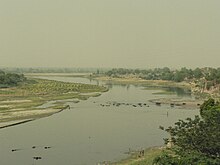
Uttar Pradesh is located in northern India. In terms of area, Uttar Pradesh is the fourth largest state in India at 240,928 square kilometers (roughly the same as the United Kingdom ). Neighboring states are Bihar in the east, Jharkhand and Chhattisgarh in the southeast, Madhya Pradesh in the south, Rajasthan in the southwest, Haryana in the west and Uttarakhand in the north. To the west, enclosed by Uttar Pradesh and Haryana, is also the capital city of Delhi . In the northeast is the border with Nepal .
The area of Uttar Pradesh lies in the Ganges plain , the low-lying plains between the Himalayas in the north and the highlands of Dekkan in the south. The terrain is extremely flat and numerous large rivers flow through it. India's longest and most important river, the Ganges , flows lengthways through Uttar Pradesh. The main tributaries of the Ganges in Uttar Pradesh are the Yamuna , which flows parallel to the Ganges before it joins it in Prayagraj (Allahabad), and the Ghaghara . Only in the extreme south does Uttar Pradesh have a share in the higher Vindhya plateau .
population
Population development
| Census year | Residents |
|---|---|
| 1951 | 60.274.800 |
| 1961 | 70.144.160 |
| 1971 | 83.849.775 |
| 1981 | 105.113.300 |
| 1991 | 132,062,800 |
| 2001 | 166.053.600 |
| 2011 | 199.812.341 |
Due to the high birthrate in the state, population growth is above the Indian average. Between 2001 and 2011, the population grew by 20 percent, faster than the Indian average (18 percent). Overall, the population of Uttar Pradesh (within today's boundaries) grew from around 60 million in 1951 to around 200 million in 2011.
Demographics
According to the 2011 Indian census, the population of Uttar Pradesh is 199,812,341. Uttar Pradesh is by far the most populous state in India and also the most populous subnational entity in the world. If Uttar Pradesh were an independent state, it would come fifth in the list of countries with the largest population between Indonesia and Brazil . With 829 inhabitants per square kilometer, Uttar Pradesh is very densely populated. The population density is the fourth highest of all Indian states and is well above the national mean of 382 inhabitants per square kilometer (for comparison: 225 people live in one square kilometer in Germany). Nevertheless, Uttar Pradesh is largely rural: only 22 percent of Uttar Pradesh's inhabitants live in cities. The degree of urbanization is thus below the overall Indian average of 31 percent. The gender ratio is unbalanced: for every 1,000 men there are 912 women, while the corresponding figure for India as a whole is 943. Among the 0 to 6 year olds there are only 902 (India: 919). In 2011, 20.7% of the population belonged to the so-called Scheduled Castes and only 0.6% to the Scheduled Tribes (the Adivasi population).
68 percent of Uttar Pradesh's residents can read and write (men 77 percent, women 57 percent). The literacy rate is thus lower than the national average of 73 percent. Between 2010 and 2014, the average life expectancy was 64.1 years (the Indian average was 67.9 years). The fertility rate was 2.64 children per woman (as of 2016) while the Indian average was 2.23 children in the same year.
- Socio-economic indicators (based on the 2011 census)
languages
| Languages in Uttar Pradesh | ||||
|---|---|---|---|---|
| language | percent | |||
| Hindi | 91.3% | |||
| Urdu | 8.0% | |||
| Other | 0.7% | |||
| Distribution of languages (2001 census) | ||||
The main language of Uttar Pradesh is Hindi , India's national language and the most widely spoken language in the country. According to the 2001 census, 91 percent of the state's residents speak Hindi as their first language. This number also includes speakers of various regional languages closely related to Hindi, which the Indian government classifies as Hindi dialects. This includes, for example, Bhojpuri , which has a total of over 30 million speakers in eastern Uttar Pradesh and neighboring areas. Urdu is common among Muslims in Uttar Pradesh and was given as the mother tongue of eight percent of the state's population in the census. As everywhere in India, English is ubiquitous as a communication and educational language. Hindi is the official language of Uttar Pradesh. Urdu is also used as the second official language for certain purposes.
Religions
| Religions in Uttar Pradesh | ||||
|---|---|---|---|---|
| religion | percent | |||
| Hinduism | 79.7% | |||
| Islam | 19.3% | |||
| Other | 1.0% | |||
| Distribution of religions (2011 census) | ||||
According to the 2011 census, 80 percent of Uttar Pradesh's population are Hindus . There is also a large Muslim minority of 19 percent. With over 38 million Muslims, Uttar Pradesh is home to the largest Muslim population of any Indian state in absolute terms. Other religions play a subordinate role: Sikhs (0.4 percent), Buddhists (0.3 percent), Christians (0.2 percent), Jainas and Buddhists (0.1 percent each) represent only small minorities.
Biggest cities
Anglicized, outdated or unofficial names are in brackets. The population figures are at the level of the 2011 census.
| city | Residents | city | Residents | ||
|---|---|---|---|---|---|
| 1 | Lucknow ( Lucknow ) | 2,815,601 | 8th | Bareilly | 898.167 |
| 2 | Kanpur (Cawnpore) | 2,767,031 | 9 | Moradabad | 889.810 |
| 3 | Ghaziabad | 1,636,068 | 10 | Aligarh | 872,575 |
| 4th | Agra | 1,574,542 | 11 | Saharanpur | 703.345 |
| 5 | Meerut | 1,309,023 | 12 | Gorakhpur | 671.048 |
| 6th | Varanasi (Benares) | 1,201,815 | 13 | Noida | 642.381 |
| 7th | Prayagraj | 1,117,094 | 14th | Firozabad | 603.797 |
history
Human artifacts that are around 21,000 to 31,000 years old have been found in what is now Uttar Pradesh. From around the 4th millennium BC The area was under the influence of the Indus culture . From around the year 1500 BC. With the immigration of the Indo-Europeans, the Vedic period began, in which Hinduism developed. Uttar Pradesh plays a prominent role in Hindu mythology. According to legend, the god-king Rama ruled here from his capital Ayodhya . Krishna, the eighth avatar of the Hindu god Vishnu, is said to be born in the city of Mathura in Uttar Pradesh.
The rule of Hindu kings ended with the onset of Islam in northern India. From around 1200 Uttar Pradesh belonged to the Sultanate of Delhi . The last sultan died in 1525 in the first battle of Panipat , fighting against the Central Asian conqueror Babur , who became the founder of the Mughal empire . The areas of today's Uttar Pradesh were acquired by the British East India Company mainly at the beginning of the 19th century from the Mughal emperors . Until 1833 they were administratively part of the Bengal Presidency , then they were constituted as separate north-west provinces , with the administrative seat changing frequently between Agra and Allahabad . In 1877, the Avadh area, annexed in 1857, was also annexed administratively. In 1902, these two provinces were also formally united and the name changed to United Provinces of Agra and Avadh ( United Provinces of Agra and Oudh , United Provinces for short ). After Indian independence, the area was finally renamed Uttar Pradesh , whereby the previously common abbreviation UP was retained.
Recently, the state has seen repeated clashes between Hindus and Muslims . On December 6, 1992, Hindu militants destroyed the 400-year-old Babri Mosque in Ayodhya to build a temple on the site. Thousands of people died across India in the armed conflict in the months that followed. In 2003 tens of thousands of radical Hindus were arrested in the state of Uttar Pradesh for demonstrating again for the building of the temple.
In 2000 the north-western part of Uttar Pradesh, the mountain regions in the Himalayas, became a separate state under the name Uttaranchal (since 2007 Uttarakhand ).
politics
Political system
The legislature of the state of Uttar Pradesh consists of a bicameral parliament . The House of Commons , the Legislative Assembly or Vidhan Sabha has 404 MPs, 403 of whom are appointed by direct election every five years and one is appointed by the governor to represent the Anglo-Indian minority. The House of Lords , the Legislative Council or Vidhan Parishad , has 100 members, 38 of whom are appointed by the House of Commons, 36 by the state municipalities, ten by the governor, and eight each by teachers and college graduates. The parliament of Uttar Pradesh has its seat in Lucknow .
The Chief Minister of the State of Uttar Pradesh is elected by Parliament. But is appointed by the President of India Governor (at the head of the State Governor ). Its main tasks are to appoint the Chief Minister and to entrust him with the formation of the government.
The highest court in Uttar Pradesh is the Allahabad High Court , based in Prayagraj .
Parties
| Distribution of seats after the 2017 parliamentary elections |
|
|---|---|
| BJP | 312 |
| SP | 47 |
| E.G | 19th |
| AD (S) | 9 |
| congress | 7th |
| SBSP | 4th |
| RLD | 1 |
| NISHAD | 1 |
| Independent | 3 |
| total | 403 |
Politics in Uttar Pradesh was dominated by the Congress Party in the early decades of the Indian Republic. This changed permanently in the 1990s. Since then, two caste-based regional parties have played a leading role: the Bahujan Samaj Party (BSP) represented the Dalits (casteless people), and the Samajwadi Party (SP) had its supporters mainly from lower castes such as the Yadav and Ahir , who barely made up the caste hierarchy Stand above the Dalits as well as the Muslims . Also an important political role played by Hindu nationalist party Bharatiya Janata Party (BJP). The Indian National Congress , on the other hand, lost a lot of its following.
The Samajwadi Party won the election for Vidhan Sabha in February 2012. It won 224 of 403 seats and thus has an absolute majority. The previously ruling Bahujan Samaj Party lost significantly and only got 79 seats. The Bharatiya Janata Party has 47 members and the Congress Party has 28 members. Also represented in parliament were the smaller regional parties Rashtriya Lok Dal , Peace Party , Quami Ekta Dal , Apna Dal and Ittehad-E-Millait Council , the Nationalist Congress Party and six independents. Akhilesh Yadav of the Samajwadi Party became Chief Minister Uttar Pradesh on March 15, 2012 . In the following election in February / March 2017, the BJP faced each other on the one hand and a coalition of the Congress Party and the Samajwadi Party. In addition, as candidates Bahujan Samaj Party of Mayawati and a number of smaller parties. The election ended with a sweeping victory for the BJP, which won a three-quarters majority of the seats. All other parties landed far behind. After the election results were announced, there was almost two weeks of uncertainty as to who would become the new chief minister. The BJP had campaigned without a clear top candidate. On March 18, 2016, the BJP announced that Yogi Adityanath , a Hindu high priest at Gorakhnath Temple in Gorakhpur, would become the future Chief Minister. The decision was very controversial in public, as Adityanath had repeatedly attracted attention through controversial and polarizing statements. The election victory of the BJP was interpreted differently. While some suggested that this was ultimately due to the popularity of Prime Minister Narendra Modi , others expressed the view that Adityanath's election shows that the BJP had conducted a highly polarizing campaign and must now address the incited emotions of the Hindu majority. On March 19, 2017, Adityanath was sworn in as the new Chief Minister Uttar Pradesh.
Concepts for the division of Uttar Pradesh into several states
The enormous size and population of the state, even by Indian standards, has led to considerations since the founding of the Indian republic in 1950 as to whether Uttar Pradesh should not be divided into several smaller individual states in order to ensure better administration and better governability. In 1951 Uttar Pradesh (then still called Uttarakhand) had 60 million inhabitants (16.7% of the Indian population), in 2011 it was 200 million inhabitants (16.5% of the Indian population). The associated relatively large political weight of the state in Indian politics has traditionally been viewed with concern, especially by the southern Indian states. As early as 1955, Bhimrao Ramji Ambedkar proposed in a small essay 'Thoughts On Linguistic States' the division of Uttar Pradesh into three individual states, each with roughly the same population and the capitals of Meerut , Kanpur and Allahabad . In the States Reorganization Act 1956, K. Madhava Panikkar , one of the three members of the States Reorganization Commission , advocated the division of Uttar Pradesh into at least two separate states, but could not prevail with this view. The subject came up occasionally in the following decades, but did not play a major role in political debates.
On November 16, 2011, the then Chief Minister Mayawati proposed the division of Uttar Pradesh into four individual states. She explicitly referred to Ambedkar's earlier proposals. The proposed states were Avadh Pradesh , Purvanchal , Bundelkhand, and Paschim Pradesh . Political observers saw the proposal, at least in part, as a political move Mayawati wanted to use to gain votes in the 2012 elections to the Uttar Pradesh parliament. On November 21, 2011, the parliament of Uttar Pradesh, in which Mayawati's Bahujan Samaj Party (BSP) had a majority, passed a resolution calling for the division of Uttar Pradesh according to Mayawati's proposal. Other parties represented in parliament supported the proposal by the little Rashtriya Lok Dal , the BJP and the Congress Party. According to the Indian constitution, an amendment to the constitution must be passed by a majority of the Indian parliament in order to create new states . The Indian central government under Prime Minister Manmohan Singh (Congress Party) initially acted on hold and a spokesman for the Congress Party described Mayawati's proposal as “political opportunism”. The main criticism was that there was no debate at all about the proposals. The parliamentary election in Uttar Pradesh was lost to Mayawati's BSP, and in its place came the rival Samajwadi Party , which did not pursue the issue. Before the 2017 general election, Mayawati announced again in her party's election manifesto that she would take up the project again if she won the election. However, the topic did not play a major role in the election campaign and the election was again lost for the BSP.
The main arguments of those in favor of partitioning are those that are classically put forward for the devolution of state power. A decentralized administration is intended to ensure better development of the individual parts of the country. However, there were also critical voices that emphasized that smaller states do not automatically guarantee better socio-economic development, as examples from the past have shown.
Administrative division
Divisions
Uttar Pradesh is divided into 18 divisions.
Districts
The state of Uttar Pradesh is divided into 75 districts . The last nationwide data collection (census) in 2011 was still carried out on the basis of the division into 71 districts. Since then, the districts of Amethi (2010), Hapur (2011), Shamli (2011) and Sambhal (2012) have been added.
| District | administrative seat |
Area (km²) |
Population (2011) |
Population density ( inhabitants / km² ) |
|
|---|---|---|---|---|---|
| 1 | Agra | Agra | 4,041 | 4,418,797 | 1,093 |
| 2 | Aligarh | Aligarh | 3,650 | 3,673,889 | 1.007 |
| 3 | Allahabad | Prayagraj | 5,482 | 5,954,391 | 1,086 |
| 4th | Ambedkar Nagar | Akbarpur | 2,350 | 2,397,888 | 1,020 |
| 5 | Amethi * | Gauriganj | - | - | - |
| 6th | Amroha | Amroha | 2,249 | 1,840,221 | 818 |
| 7th | Auraiya | Auraiya | 2.016 | 1,379,545 | 684 |
| 8th | Azamgarh | Azamgarh | 4,054 | 4,613,913 | 1,138 |
| 9 | Badaun ** | Badaun | (5,168) | (3,681,896) | (712) |
| 10 | Baghpat | Baghpat | 1,321 | 1,303,048 | 986 |
| 11 | Bahraich | Bahraich | 5,237 | 3,487,731 | 666 |
| 12 | Ballia | Ballia | 2,981 | 3,239,774 | 1,087 |
| 13 | Balrampur | Balrampur | 3,349 | 2,148,665 | 642 |
| 14th | Banda | Banda | 4,408 | 1,799,410 | 408 |
| 15th | Barabanki | Barabanki | 4,402 | 3,260,699 | 741 |
| 16 | Bareilly | Bareilly | 4.120 | 4,448,359 | 1,080 |
| 17th | Basti | Basti | 2,688 | 2,464,464 | 917 |
| 18th | Bijnor | Bijnor | 4,561 | 3,682,713 | 807 |
| 19th | Bulandshahr | Bulandshahr | 4,512 | 3,499,171 | 776 |
| 20th | Chandauli | Chandauli | 2,541 | 1,952,756 | 768 |
| 21st | Chitrakoot | Chitrakoot Dham | 3.216 | 991.730 | 308 |
| 22nd | Deoria | Deoria | 2,540 | 3,100,946 | 1,221 |
| 23 | Etah | Etah | 2,431 | 1,774,480 | 730 |
| 24 | Etawah | Etawah | 2,311 | 1,581,810 | 684 |
| 25th | Faizabad | Faizabad | 2,341 | 2,470,996 | 1,056 |
| 26th | Farrukhabad | Fatehgarh | 2,181 | 1,885,204 | 864 |
| 27 | Fatehpur | Fatehpur | 4.152 | 2,632,733 | 634 |
| 28 | Firozabad | Firozabad | 2,407 | 2,498,156 | 1,038 |
| 29 | Gautam Buddha Nagar | Greater Noida | 1,282 | 1,648,115 | 1,286 |
| 30th | Ghaziabad ** | Ghaziabad | (1,179) | (4,681,645) | (3,971) |
| 31 | Ghazipur | Ghazipur | 3,377 | 3,620,268 | 1,072 |
| 32 | Gonda | Gonda | 4,003 | 3,433,919 | 858 |
| 33 | Gorakhpur | Gorakhpur | 3,321 | 4,440,895 | 1,337 |
| 34 | Hamirpur | Hamirpur | 4,021 | 1,104,285 | 275 |
| 35 | Hapur * | Hapur | - | - | - |
| 36 | Hardoi | Hardoi | 5,986 | 4,092,845 | 684 |
| 37 | Hathras | Hathras | 1,840 | 1,564,708 | 850 |
| 38 | Jalaun | Orai | 4,565 | 1,689,974 | 370 |
| 39 | Jaunpur | Jaunpur | 4.038 | 4,494,204 | 1,113 |
| 40 | Jhansi | Jhansi | 5,024 | 1,998,603 | 398 |
| 41 | Kannauj | Kannauj | 2,093 | 1,656,616 | 792 |
| 42 | Kanpur Dehat | Akbarpur | 3,021 | 1,796,184 | 595 |
| 43 | Kanpur Nagar | Kanpur | 3,155 | 4,581,268 | 1,452 |
| 44 | Kasganj | Kasganj | 1,955 | 1,436,719 | 735 |
| 45 | Kaushambi | Manjhanpur | 1,779 | 1,599,596 | 899 |
| 46 | Kushinagar | Padrauna | 2,905 | 3,564,544 | 1,227 |
| 47 | Lakhimpur Kheri | Lakhimpur | 7,680 | 4,021,243 | 524 |
| 48 | Lalitpur | Lalitpur | 5,039 | 1,221,592 | 242 |
| 49 | Lucknow | Lucknow | 2,528 | 4,589,838 | 1,816 |
| 50 | Maharajganj | Maharajganj | 2,952 | 2,684,703 | 909 |
| 51 | Mahoba | Mahoba | 3,144 | 875,958 | 279 |
| 52 | Mainpuri | Mainpuri | 2,760 | 1,868,529 | 677 |
| 53 | Mathura | Mathura | 3,340 | 2,547,184 | 763 |
| 54 | Mau | Mau | 1,713 | 2,205,968 | 1,288 |
| 55 | Meerut | Meerut | 2,559 | 3,443,689 | 1,346 |
| 56 | Mirzapur | Mirzapur | 4,405 | 2,496,970 | 567 |
| 57 | Moradabad ** | Moradabad | (3,718) | (4,772,006) | (1,283) |
| 58 | Muzaffarnagar ** | Muzaffarnagar | (4,008) | (4,143,512) | (1,034) |
| 59 | Pilibhit | Pilibhit | 3,686 | 2,031,007 | 551 |
| 60 | Pratapgarh | Bela Pratapgarh | 3,717 | 3,209,141 | 863 |
| 61 | Raebareli ** | Raebareli | (4,609) | (3,405,559) | (739) |
| 62 | Rampur | Rampur | 2,367 | 2,335,819 | 987 |
| 63 | Saharanpur | Saharanpur | 3,689 | 3,466,382 | 940 |
| 64 | Sambhal * | Sambhal | - | - | - |
| 65 | Sant Kabir Nagar | Khalilabad | 1,646 | 1,715,183 | 1,042 |
| 66 | Sant Ravidas Nagar | Gyanpur | 1,015 | 1,578,213 | 1,555 |
| 67 | Shahjahanpur | Shahjahanpur | 4,388 | 3,006,538 | 685 |
| 68 | Shamli * | Shamli | - | - | - |
| 69 | Shravasti | Shravasti | 1,640 | 1,117,361 | 681 |
| 70 | Siddharthnagar | Navgarh | 2,895 | 2,559,297 | 884 |
| 71 | Sitapur | Sitapur | 5,743 | 4,483,992 | 781 |
| 72 | Sonbhadra | Robertsganj | 6,905 | 1,862,559 | 270 |
| 73 | Sultanpur ** | Sultanpur | (4,436) | (3,797,117) | (856) |
| 74 | Unnao | Unnao | 4,558 | 3,108,367 | 682 |
| 75 | Varanasi | Varanasi | 1,535 | 3,676,841 | 2,395 |
*) Newly founded after the 2011 census, figures are not available.
**) Reduced in size after the 2011 census due to the separation of new districts, figures refer to the district within the boundaries of 2011.
Local self-government
At the end of 2014 there were 14 Municipal Corporations ( Nagar Nigam ) in Uttar Pradesh .
Municipal Corporations :
economy
| sector | Employees absolutely |
in percent |
|---|---|---|
| farmers | 19,057,888 | 29.0 |
| Farm workers | 19,939,223 | 30.3 |
Small domestic industry |
3,898,590 | 5.9 |
| Other workers | 22,919,014 | 34.8 |
| total | 65,814,715 | 100.0 |
Uttar Pradesh is one of the poorest states in India and is still largely agricultural. The soils of the fertile Ganges plain allow two harvests per year in some places. The state has significant underemployment and the labor force participation rate is comparatively low. In the 2011 census, 65,814,715 people (32.9% of the total population ) were counted as workers . 15,967,953 (24.3%) of these were women. Of the workers, 21,179,223 people (almost a third) were classified as marginal workers .
Between 1998 and 2014, India's average annual economic growth was 6.39%. In Uttar Pradesh, however, it was only 5.29%.
With a value of 0.566, Uttar Pradesh ranks 28th among the 29 states of India in the human development index in 2015 . Only Bihar achieved an even worse ranking.
Significant trading cities in addition to the state capital Lucknow are Muradabad (known for metalworking), Varanasi (for saris and silk ), Mirzapur (for the carpet industry in the area), Kanpur and Agra (both for leather goods). Prayagraj and Noida are considered industrial cities .
health
In the districts of Etawah , Banda and Lalitpur , more than 1 percent of pregnant women are now (2007) infected with HIV .
Attractions
The main tourist attractions in Uttar Pradesh are the city of Agra with the Taj Mahal mausoleum and the Red Fort , as well as the cities of Varanasi and Fatehpur Sikri . Increasingly also Kushinagar , one of the four great Buddhist pilgrimage sites.
Web links
Individual evidence
- ^ Population of Indian States. (PDF) Retrieved March 18, 2018 .
- ^ Census of India 2011: Primary Census Data Highlights - India. Chapter 1 (Population, Size and Decadal Change) (PDF; 9.2 MB).
- ↑ a b c d Census of India 2011: Primary Census Abstract - Uttar Pradesh (PDF; 1.7 MB).
- ^ Census of India 2011: Primary Census Data Highlights - India. Chapter 3 (Literates and Literacy Rate) (PDF; 2.7 MB).
- ^ Indian States by Life Expectancy 2010-2014. (PDF) Retrieved March 19, 2018 .
- ^ Fertility Rates. (PDF) Retrieved March 19, 2018 .
- ^ Census of India 2001: Distribution of 10,000 Persons by Language - India, States and Union Territories .
- ↑ Census of India 2011: Population by religious community.
- ^ Census of India 2011: Provisional Population Totals. Cities having population 1 lakh and above. (PDF; 154 kB)
- ↑ MR Giblinga, R. Sinhab, NG Royb, SK Tandonc, M. Jain: Quaternary fluvial and eolian deposits on the Belan river, India: paleoclimatic setting of Paleolithic to Neolithic archeological sites over the past 85,000 years . In: Quaternary Science Reviews . tape 27 , no. 3–4 , February 2008, pp. 391-410 , doi : 10.1016 / j.quascirev.2007.11.001 (English).
- ^ Election Commission of India.
- ↑ Uttar Pradesh election results 2017 live: Historic win for BJP, Akhilesh says 'our struggle will continue'. livemint.com, March 12, 2017, accessed March 12, 2017 .
- ↑ a b Yogi Adityanath: Uttar Pradesh chief minister choice criticized. BBC News, March 18, 2017, accessed March 19, 2017 .
- ↑ Hindutva vs Hinduism: Adityanath's appointment shows BJP has little faith in its development plank. scroll.in, March 19, 2017, accessed on March 19, 2017 (English).
- ↑ Highlights: Yogi Adityanath Sworn In As The New Chief Minister Of Uttar Pradesh. NDTV, March 19, 2017, accessed on March 19, 2017 .
- ^ TK Arun: India has too few states; set up a new States Reorganization Commission without delay. The Economic Times, February 19, 2014, accessed July 1, 2017 .
- ^ UP too large to administer, split it into smaller states: Jairam Ramesh. firstpost.com, February 24, 2014, accessed July 1, 2017 .
- ↑ 9.7 POPULATION OF INDIA (1951-2001). (PDF) (No longer available online.) Ministry of Finance of India, archived from the original on December 19, 2008 ; accessed on July 1, 2017 . Info: The archive link was inserted automatically and has not yet been checked. Please check the original and archive link according to the instructions and then remove this notice.
- ↑ Size, Growth Rate and Distribution of Population. (PDF) Census of India 2011, accessed on July 1, 2017 .
- ^ BR Ambedkar: Thoughts on Linguistic States . Anand Sahitya Sadan, Aligarh, Chapter VII: The division of the North (English, online - first edition: 1955).
- ^ A b Nilakantha Rath: Separation is no solution to the problem of regional imbalance in development . In: Journal of Indian School of Political Economy . tape 21 , no. 1-4 , 2009, pp. 193–197 (English, online [PDF]).
- ↑ India: Mayawati proposes division of Uttar Pradesh. BBC News, November 16, 2011, accessed July 1, 2017 .
- ^ Division of UP: A reality check. The Hindustan Times, November 15, 2011, accessed July 1, 2017 .
- ↑ Manjari Mishra, Ashish Tripathi: Mayawati cabinet proposes division of Uttar Pradesh into four states. The Times of India, November 15, 2011, accessed July 1, 2017 .
- ^ UP Assembly passes resolution on state's division into four. indiatoday.in, November 21, 2011, accessed July 1, 2017 .
- ↑ a b UP elections 2017: Demand for division of state loses steam in 2017 polls. The Indian Express, February 16, 2017, accessed July 1, 2017 .
- ^ Division of UP: A reality check. Hindustan Times, November 15, 2011, accessed July 1, 2017 .
- ^ Liz Mathew: UP assembly passes resolution to break up state into four parts. livemint.com, November 21, 2011, accessed July 1, 2017 .
- ↑ Sharat Pradhan: UP assembly okays resolution to DIVIDE the state. rediff.com, November 21, 2011, accessed July 1, 2017 .
- ^ Firozabad, UP's 14th municipal corporation . The Indian Express. September 25, 2014.
- ^ Sub-national HDI - Area Database - Global Data Lab. Retrieved August 12, 2018 .
- ^ Sunil Raman: India alarm over HIV in new areas. In: news.bbc.co.uk. May 30, 2007, accessed February 28, 2015 .
Coordinates: 27 ° 0 ' N , 81 ° 0' E



